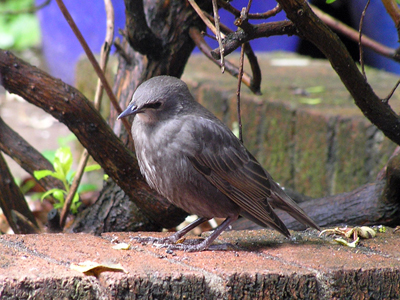I have never really liked starlings, but I have to admit I am taking an interest now they have moved into our garden for the breeding season, making lightning raids for raisins from the bird table.
They are so annoying for the amateur photographer, too, as they make a racket, arrive to do their quick thieving and then dash off again before you can even get your camera out. Thus the few pictures I have taken so far are a bit blurred!
Usually I have seen gangs of rough and noisy starlings on neighbours’ lawns, spearing leatherjackets, no doubt, with their very hard and pointed beaks. But they rarely come into our wooded garden.
Then a week or so ago one arrived on the fence and surprised me as much as if it had been an exotic species and not one of Britain’s commonest 60 native birds.
At the moment we have only three starlings in the garden raiding party, but I have seen groups of a dozen on lawns here in the city and they can come together in huge flocks for roosting.
I remember seeing (and hearing!) them in the city of Newcastle one evening long ago but I think the buildings have probably been covered in nets now to keep them off.
The European starling (Sturnus vulgaris) can find food almost anywhere but prefers feeding on pastures and lawns as it enjoys insect larvae (such as the leatherjackets mentioned above, larvae of the crane-fly) and worms.
While a group of blackbirds or thrushes spread out to look for exposed targets, starlings work in an almost industrial way, feeding close together and moving in the same direction, excavating for invertebrates by repeatedly thrusting the bill into the ground and opening it.
Most starlings rear only one brood a year. The male makes messy nest foundations from grass and straw and the female adds a feather lining. There are four to seven blue-white eggs, hatching in 12 or 13 days. Fledging takes about three weeks.
Out and about, the grey-brown young always stay close to an adult –sometimes even treading on a parent’s heels.
The name starling probably comes from the Anglo-Saxon staer and staerlinc. Many other European languages have similar names for the bird, such as star (German), stare (Swedish) and storno (Italian). In French it’s étourneau (I am guessing there is a lost “S” in there somewhere and the old French may have been something like estourneau) and of course the Latin name is sturnus.
The old Greek psaros means “spotted or flecked” and I suppose that must be the origin of the name, from the white-flecked winter plumage of the starling. Although I would prefer to think of it as meaning a “little star”, from the beautiful rainbow-black summer plumage…









[…] There are some better photos and more information on this blog post here. […]
Thank you for your kind link – loved your post about a murmuration of starlings and I am now following your blog.
best wishes 🙂